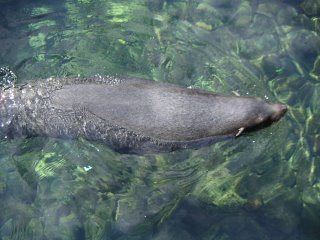Animal Encounters VIII
Now that the weather is excellent, the animals are almost raring to go! For this eighth edition, we've got:

The fur seals belong to the same family as sea lions (Otariidae, meaning eared seals). They are more agile on land than the 'earless' seals as they can move their hind limbs forward underneath their body which is raised as they move. Using their front and hind flippers alternately, they can move almost at a gallop on land. In the water the front flippers are used in a rowing movement but the rear flippers are not used at all. The fur seals also have a different type of coat from that of the sea lion, having considerably more secondary hairs, forming a dense undercoat which effectively insulates the body. Other seals have a thick layer of blubber to keep them warm, rather than a layer of "fur". Bulls grow to an average length of 6 ft. (1.9 m) and a weight of 348 lb (158 kg), cows being considerably smaller at 4.5 ft (1.4 m) and a weight of only 110 lb (50 kg).

In the breeding season, this species prefers rocky coasts, where adults haul out onto the rocks. They are particularly numerous on the coast of Uruguay and numbers are stabilising or increasing in other areas since hunting has been controlled. When not at their breeding colonies, these superbly adapted marine mammals spend their time hundreds of miles from land chasing shoals of fish and small shrimps called krill. They can sometimes be seen in the open ocean breaking the water surface to breathe. Their natural enemies in the open ocean are sharks and killer whales.
The South American Fur Seal

The fur seals belong to the same family as sea lions (Otariidae, meaning eared seals). They are more agile on land than the 'earless' seals as they can move their hind limbs forward underneath their body which is raised as they move. Using their front and hind flippers alternately, they can move almost at a gallop on land. In the water the front flippers are used in a rowing movement but the rear flippers are not used at all. The fur seals also have a different type of coat from that of the sea lion, having considerably more secondary hairs, forming a dense undercoat which effectively insulates the body. Other seals have a thick layer of blubber to keep them warm, rather than a layer of "fur". Bulls grow to an average length of 6 ft. (1.9 m) and a weight of 348 lb (158 kg), cows being considerably smaller at 4.5 ft (1.4 m) and a weight of only 110 lb (50 kg).

In the breeding season, this species prefers rocky coasts, where adults haul out onto the rocks. They are particularly numerous on the coast of Uruguay and numbers are stabilising or increasing in other areas since hunting has been controlled. When not at their breeding colonies, these superbly adapted marine mammals spend their time hundreds of miles from land chasing shoals of fish and small shrimps called krill. They can sometimes be seen in the open ocean breaking the water surface to breathe. Their natural enemies in the open ocean are sharks and killer whales.
Like all fur seals, this species was hunted almost to extinction for their rich, warm fur. Until very recently they were still being killed in Uruguay, but in 1991 the hunt was finally stopped. Another growing threat may be the reduction of fish stocks that the seals depend on, as a result of large-scale industrial fishing.
At Bristol Zoo Gardens, the seals enjoy the water. Lots of objects are put in the pool to keep them occupied such as rafts, floating logs and balls. They swim around and climb on top of these "toys". They are sometimes given ice blocks with frozen fish or fish blood inside. They play with them as they melt and obtain the treat inside. Food balls are attached to buoys which they have to play with and knock about until food falls out. This stimulates the behaviour that is natural to them in the wild.
Recently, the female seal has given birth to two pups, of which one is on show while the other is still in care. There's been plenty of new births at the zoo recently and I'll be profiling the cute newcomers in the following weeks to come.





0 Comments:
Post a Comment
<< Home